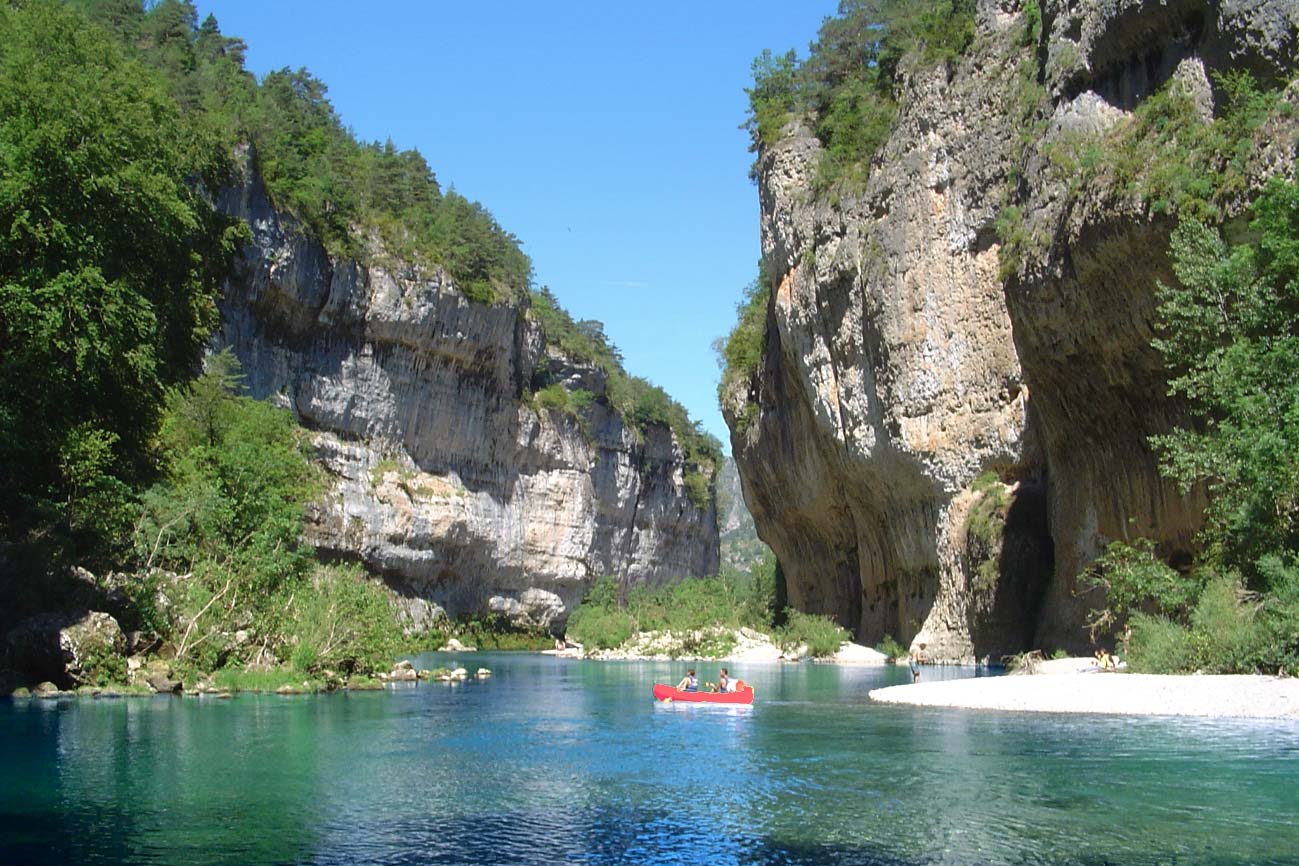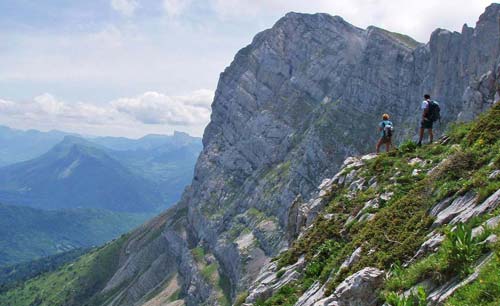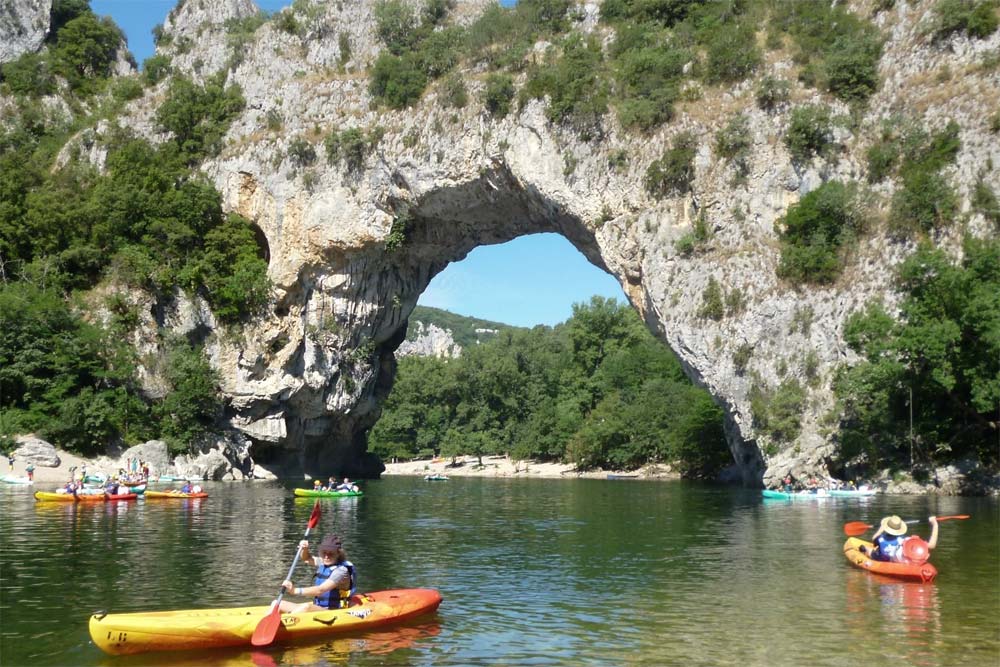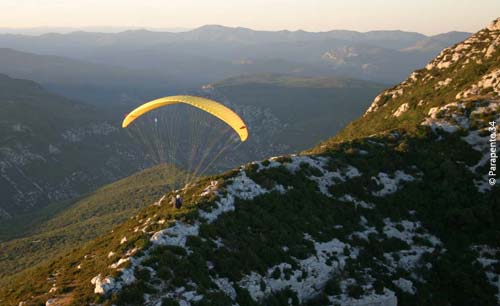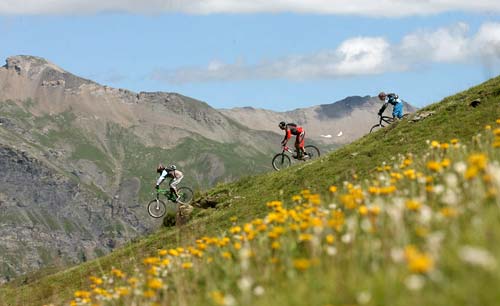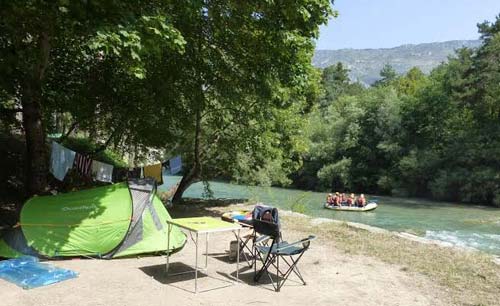High altitude thrills in Chamonix
Chamonix is a Mecca for thrill-seekers from all sporting persuasions who arrive in their droves keen to explore (or ski, or climb, or jump off) the endless hidden pleasures of the Mont Blanc Massif.
Chamonix is one of the oldest ski resorts in France. However you like your sports, your après and your lodgings, Chamonix has what you’re looking for in spades. Here are a some of the best activities to get your heart pumping…
Chamonix Winter Activities
Skiing
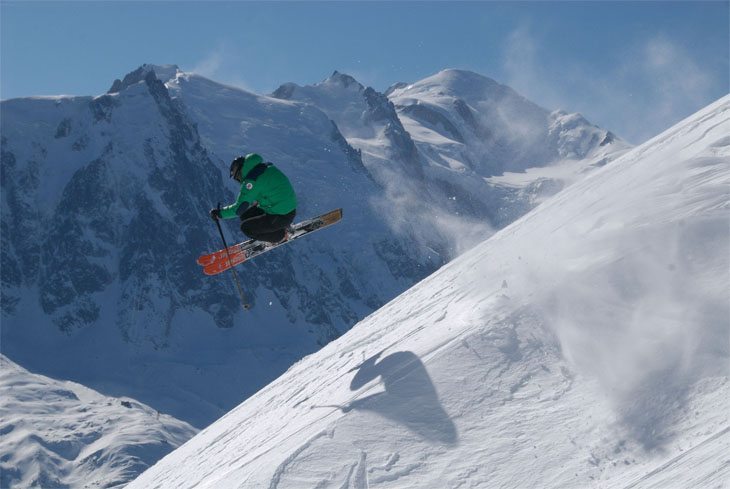
Freeskiing in the Mont Blanc Massif, Chamonix | © mountaindayz.com
Chamonix is the jewel in the Alpine crown. Comprising 4 peaks and 157 km of on-piste for all levels, as well as immense and legendary off-piste, Chamonix offers endless opportunities for skiing.
For many advanced skiers, the real draw of Chamonix is the off-piste.
While Chamonix is probably best known for the challenges that it offers to the expert skier, novices are also well catered for. Les Planards, Le Tour, Argentiere/Les Grands Montets, Vallorcine, and Chamonix/Brevent, as well as Les Houches all offer ample space and gentle terrain for the beginner to get his or her snow plough on. And where better to learn?! Learning to ski in Chamonix must be incredible – like learning to drive at the Nuremburg ring.
Once the trusty snow plough is under your belt then Chamonix is really ready to show off her exquisite variety. Brevent-Flegere is a great mixed terrain sector which has the added bonus of being south facing and thus enjoying the most pleasant weather in all of Chamonix. Brevent Flegere is great for families and groups of mixed abilities and could easily be explored for a full week. Le Tour and Les Houches also offer extensive intermediate options.
For the advanced skier, Chamonix is the number 1 Alpine playground. Apart from the unrivalled off-piste (discussed below), it offers an extensive variety of thigh-grinding on-piste challenges for even the most expert skier. Hit up Les Grands Montets for steep, narrow blacks (officially the greatest height losses in the world!) with phenomenal views. You will also find some good blacks at Brevent Flegere – in particular check out Charles Bozon run for crazy, crazy moguls.
If freestyle is your thing you will also find a snowpark in Les Grands Montets. For many advanced skiers, the real draw of Chamonix is the off-piste. Off-piste opportunities can be found in each of the five ski areas. It’s not a bad idea to hire a guide to direct you to the most exhilarating, most powdery, most mogully hidden gems.
Access and Ski Passes:
The Mont Blanc Unlimited Lift Pass will give you full coverage for all three major cable cars (6 day adult pass = 285 euros, children = 242 euros). If you’re not planning to hit up the summit of Les Grands Montets a cheaper option would be the Chamonix Le Pass (241e / 205 euros).
Snowboarding
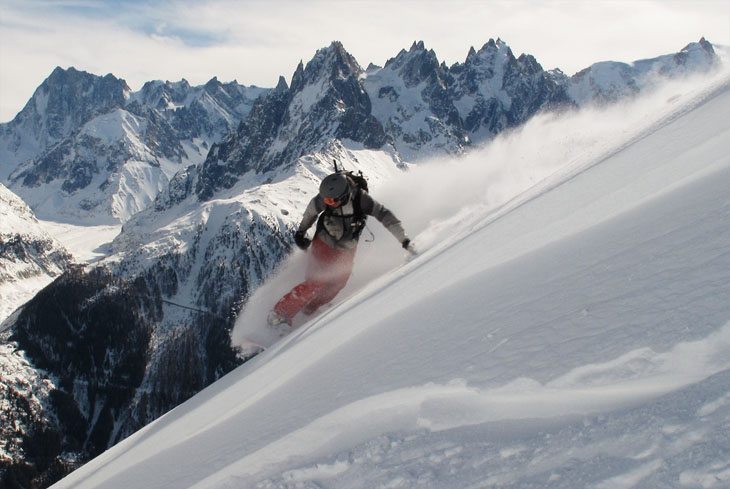
Freeride snowboarding in Brevent-Flegere, Chamonix | © chaletlaforet.com
There are several snowparks that are relatively recent additions to the Chamonix portfolio of boarding amenities. The largest is the Summit Snowpark which can be found at the top of Les Grand Montets (you can access the park via the Marmottons Chair or the Tabe Chair) and features modules for all abilities. This park is covered by a video system allowing you to opt to record your skills for playback once you reach the end of the run.
Le Brevent-Flegere offers a ton of natural kickers and boasts delightful conditions for getting some air, safe in the knowledge that you’ll be returning to earth onto a huge pillow of powder! You’ll find a further snowpark in Les Houches and recently a beginners snowpark has been added at La Vormaine.
The 5 ski areas in Chamonix are filled with great on piste opportunities that tend to favour the intermediate to advanced snowboarder. While there are definitely areas where it is safe for beginners to struggle through their first thousand face-plants, the real beauty of the skiing in Chamonix is only really accessible to those who can confidently access and navigate challenging terrain.
The real draw of Chamonix for a boarder is the off piste. Chamonix is a freeriding paradise with some estimating that 75% of the best boarding terrain being off the beaten track. This is hardcore freeriding and won’t be beaten anywhere else in Europe (possible even the world!). The Vallee Blanche famously offers 20km of off piste riding and is a must-board when you’re in the area. Again, it is advised to get a guide to explore the off piste as Chamonix is just so massive – Neil McNab offers freeride and off piste technique courses along with off piste tours in Chamonix and the surrounding areas, so you’ll be in good company!
To get the most of the freeriding in Chamonix be prepared to be up early and ensure that you are well prepared with the equipment you need. You will need, at a minimum, a transceiver, a back pack, a shovel and a probe. Remember, this is hardcore – so prepare properly and be safe!
Aiguille du Midi & Vallee Blanche
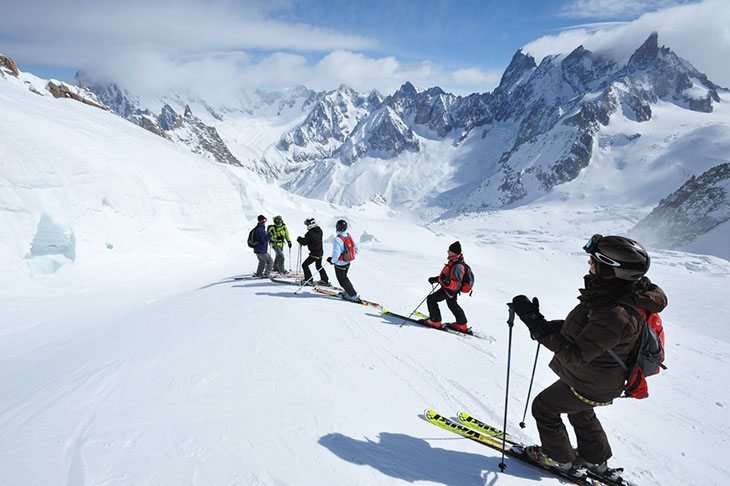
Vallée Blanche, Chamonix – an all-day backcountry adventure | © Pieter Ter Kuile
The Vallée Blanche is one of the most exciting skiing / snowboarding experiences in the world. In brief, it is a 20km long off piste route that comprises a drop of just under 3000m. Everything about the Vallee Blanche is epic and it’s included in our feature on the Best Ski Runs in the France.
To access the Vallee Blanche you should take the Aiguille du Midi cable car. The cable car was built in 1955 and at the time was the highest cable car in the world – it is still the cable car with the highest vertical ascent. From the car you can enjoy breathtaking views of the Alps. The journey to the peak is split in two with an option to get off at the mid-point (Plan de L’agiulle) – you might get out here if you were planning to do some mountaineering or rock climbing.
If you decide to go right on up to the top you will be rewarded with the most exquisite Alpine views. If you wish to save the experience for posterity you can purchase postcards at the top and post them to jealous friends and family using the peaks own stamps! For those of you who aren’t averse to extreme heights you can choose to experience ‘Step into the Void’ – a glass tunnel suspended over a 1000m drop. Not for me but different strokes for different folks I suppose.
The Aiguille du Midi is understandably a busy, busy lift. It is recommended that you book your ascent in advance as otherwise the queues can be incredibly frustrating.
To get to the Vallee Blanche after exiting the cable car you have to traverse a terrifying ridge called simple the ‘arête’, a tiny pathway bordered on each side with nothing but a 3km, vertigo-inducing vertical drop. If you can manage this section you’ll be ready for anything.
There are four main routes by which to descend the mountain. The Voie Normal is the most straightforward descent, however don’t be deceived by this description – you still need to be a fairly strong intermediate skier to safely navigate your way down.
More experienced skiers might consider the Gros Rognon and the Vrai Vallee Blanche routes which are more technically challenging and involve glacier crevasses and fast pitches. For the most advanced skiers or snowboarders the Petit Envers du Plan or Grand Envers du Plan will provide some of the most exciting, interesting, beautiful and challenging runs of your life.
The Vallee Blanche is best enjoyed over a full day (if you want to take in the beautiful views and maybe stop at one of the restaurants along the way), though you could fit in two runs if you were so inclined (but on the second run you’ll have to deal with the 7 million people trying to get on the cable car later in the day!). Unless you are very familiar with the Vallee Blanche you will get much more out of the experience if you bring a guide. Avalanches are a real possibility in this area so please bring someone who knows how to say safe.
Chamonix Summer Activities
Mountain Biking
XC, Downhill and Freeride mountain biking in Chamonix
Every rider, from the novice to the advanced will find terrain to suit their mood, ability and desire in Chamonix. The 6 lifts that service the area are open from Mid June until September, after the Chamonix council have spent the spring clearing, repairing and maintaining the trails for your riding pleasure.
Tricky, technical trails are complemented by nice winding routes that weave in and out of the picturesque Alpine villages in the valley. In fact, if you’re just getting into mountain biking, Chamonix and its surrounds are a great place to work on your skills and build up your confidence on varied terrain. There are a couple of biking schools that will instruct you in technique while guiding you to the best spots the mountain has to offer. Is there any better way to spend a holiday?!
If you’re looking for a fairly easy cross-country riding experience you should check out the trails alongside the river L’Arve. For something a fair bit more demanding check out the Petit Balcons Nord and Petit Balcons Sud. For downhill just jump aboard any of the lifts and you’ll find a plethora of options.
If you’re feeling super motivated and ready for a challenge, you could try the Tour du Mont Blanc during which you will cover the whole Mont Blanc Massif taking in the incredible views and passing back and forth over the boundaries of France, Switzerland and Italy. The whole tour should take around 5 days and there are various refuges along the way where you can rest your weary body. Be warned though that there are sections of this tour where you will be required to carry your bike over fairly extended distances.
If you don’t fancy lugging your bike all the way to the Alps, there are many bike rental outlets in Chamonix where you can rent everything from a common and garden variety mountain bike to something quite special! Rental prices tend to be between 20 and 90 euro per day. If you’re bringing kids with you can rent a bike for them for around 15e per day. (Also, if you’re bringing your kids mountain biking in Chamonix you are officially the best parent ever!)
Bear in mind that there is some serious rough riding around the Chamonix valley and you will regret it if you don’t get a good tune-up of your bike before you leave. Don’t leave anything to chance, get yourself some hard wearing tyres and spare yourself the misery of stopping an incredible downhill experience to fix a tyre.
Remember that Chamonix is also a haven for hikers and during the months of July and August many of the trails are either reserved for hikers only, or there are restrictions applied to mountain bikers.
Climbing and Mountaineering
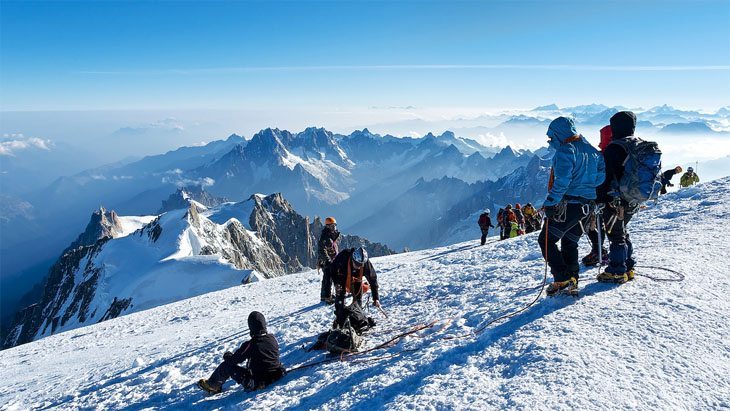
Climbers looking north-east from the summit of Mont Blanc | © Tom Fahy
Whatever you want to climb and whenever you want to climb it, Chamonix has it all – from rock falls, to ice falls, snow routes, to ice routes, crags, bouldering, climbing walls and of course, the summit of Mont Blanc itself.
Chamonix is the Alpinists playground. Despite its magnitude, Chamonix offers climbing options that are suitable for all mountaineers and would-be mountaineers. The natural features of the valley create an ideal climbing environment and a network of climbing resources has built up in the area to facilitate every type of climbing adventure imaginable. The lift / cable car system presents a tempting array of starting off points throughout the valley and there are training courses and mountain guides aplenty to ensure that you not only test and improve your skills, but also get the very best of the range.
There are a number of routes by which the formidable Mont Blanc can be scaled, both from the French side and the Italian side. These routes range from the ‘normal’ routes (one on either side) which, though the least technically challenging, still presents significant risks from ice and rock fall, to the Innominata which should only be tackled by the most experienced climber. Though a popular spot for climbing holidays, don’t be deceived into thinking that Mont Blanc is a soft touch. There are numerous fatalities on the mountainside each year, and many more mountainside rescues.
In winter months the enthusiastic alpinist can tackle the 200 ice falls, snow routes and mixed routes. There are routes that even first timers can easily manage (La Cremerie ice fall is a well-know hotspot for trying out crampons for the first time). If the weather is just too bad you can get your fix at one of the local climbing walls – you will find these at Les Houches, two in Chamonix and one in nearby Megeve.
In summer if you fancy something a bit different there are plenty of beautiful spots for bouldering (including areas specifically for kids). Beginners bouldering can be found on the French side of Col des Montets (3 – 7c). If this area gets a bit busy you might find that the boulders at Medonnet and Les Houches Coupeau are quieter, shadier and more pleasant.
Via ferrata are routes built into the mountainside that require part walking and part climbing. Travellers are assisted in their journey by ladders, cables and abseiling points. Via ferrata is a new sport that is definitely worth a go. Located high on the Plateau d’Assy, the Via Ferrata de Curalla snakes up a south facing limestone ridge with spectacular views over the Mont Blanc range. It’s recommended that you take a guide at least for your first time.
Please leave a comment below if you need specific advice for your trip to Chamonix, or if you have any recommendations to help us improve this guide. Happy holidays!

